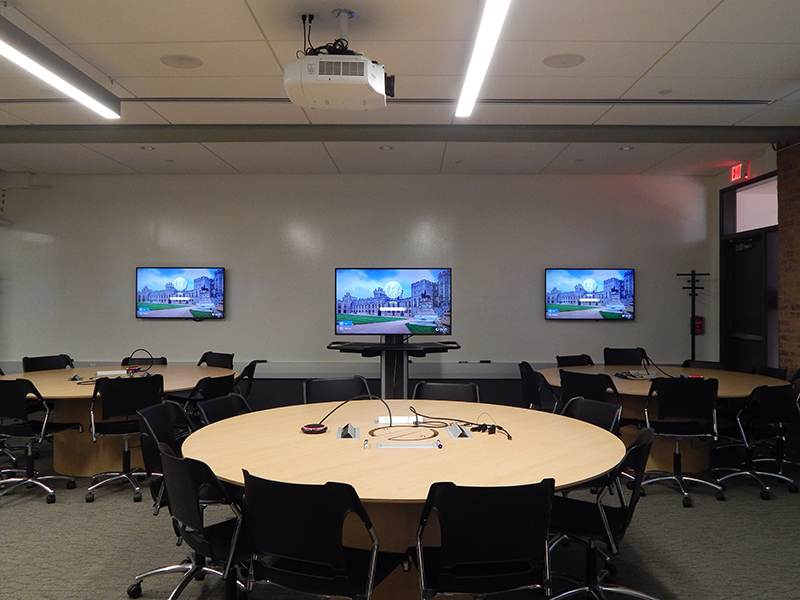SCALE-UP Classroom, New Jersey Institute of Technology, Newark, NJ

In their own words, New Jersey Institute of Technology Director of Media and Technology Support Services Joe Bonchi and Director of Digital Learning Mike Koskinen describe how they designed and installed the innovative SCALE-UP active learning space at NJIT.
The Brief
Joe Bonchi: Some of the college’s instructors approached us to develop an active learning space they could use to improve the way they work with students on certain projects and exercises. They were looking to utilize a group workspace that allowed for the kind of environment where students could present their work to the professor and the group, in contrast to the traditional model where the professor presents to a room full of students.
Mike Koskinen: They wanted a space that encourages learning out of the traditional lecture hall format. It had to be student centered, where the instructors are more on the side working with the students instead of presenting their content. We started researching spaces that promoted active learning and teaching in a different way. In the large lecture spaces there’s a lack of intimacy for learning; we wanted an intimate active learning environment. This is an increasingly popular teaching methodology, the idea being that the instructors use activities to engage their students and promote them thinking critically and analytically.
We began to develop and work on various classroom spaces, but the most exciting was in our Central King Building where we designed a “SCALE-UP” classroom. SCALE-UP is an abbreviation of “student center active learning environment with upside-down pedagogy.” The idea is it’s flipping the model of traditional instruction where the instructor talks for 2.5 hours, the students listen, and then they leave. Here it’s in reverse: students are working on projects together and sharing with the instructor and the class. They are actively doing their work in the class.
 SCALE-UP Classroom – Opened November 2016, installation completed in 2018
SCALE-UP Classroom – Opened November 2016, installation completed in 2018
The Challenge
JB: The main challenge for us was designing the classroom within the limits of a 100-year-old building, a historical site that was being renovated and modernized. It had previously been a high school adjacent to our facility, but the school moved and we took over the building. So, we had to work in the space that was provided, rather than designing from the ground up. There were definitely some limitations due to the age of the building, and we had to make some compromises to make it come out well. Space was a little tighter than we’d have liked, for example. But the building was gutted down to the wall, so we were able to build the SCALE-UP classroom from scratch, including determining the precise layout of the classroom and choosing the furniture. And we now have our newest and most modern teaching spaces in this building.
The Work
JB: To start with, we reached out to our faculty and got input on what they needed. Mike did a number of survey and focus groups, and we sat with architects and AV design consultants to determine how to make this room work. This was phase three of a three-phase project in this building and we’d already done other floors, so we had a lot of opportunity to understand the building, which was very helpful.
We were part of a large team that included architects, representatives from real estate and development at the university, people from our group and people from supporting facilities on the campus, all collaborating with design and implementation, the systems integrator, and the AV consultant we hired. We had weekly brainstorming meetings and, where possible, we were able to make small changes during the process. There were several levels of committees that had to be consulted, and feedback integrated, but overall the project went well. All through the process we shared what was going on with all the stakeholders to ensure it met goals of the university.
MK: One of the very satisfying aspects was working with the college instructors and being able to say, ‘What would you like to do?’ and being able to empower them to do it.
The Goal
MK: The goal was to create a learning space that emphasizes the students and not the authority of the instructor. In the SCALE-UP classroom, students can work together in groups on projects and interact with projects or actually touch and feel things rather than look at pictures on a screen.
JB: We wanted to give the instructors an interactive teaching environment where they could teach active learning. The classroom provides up to 90 seats configured as 10 tables of 9 chairs and there is a traditional projector at each end of the classroom. Each table has its own 60-inch monitor, which students can plug their PCs into and work together as a group. Any of the groups can work independently or collaboratively in any combination, depending on how the students want it to work. The instructor can take their content and share it from the podium in the center of the room with any of the 10 tables or with the entire class. It’s very interactive. In a regular classroom, groups would have to come one after the other, plug their computer in while everyone waits — it can be quite tedious. Here there’s a microphone at every table, and it creates a relaxed environment for groups to present together.
 SCALE-UP Classroom – Opened November 2016, installation completed in 2018
SCALE-UP Classroom – Opened November 2016, installation completed in 2018
The Successes
MK: When we launched the SCALE-UP classroom in early 2018, one of our professors presented an active learning speaking engagement in the room with 70 students and staff, to promote the room itself and active learning on our campus. That helped to raise awareness. Although there was already high demand from our instructors, change takes time.
JB: Over the summer we had the opportunity to shape the room and make some tweaks and by the fall, we had a full house. At this point, the demand on the room exceeds the availability, so we feel we succeeded. We have a lot of people wanting to use that space.
MK: We have gotten incredible feedback from the instructors about the space. We measure it by demand; it’s very hard to book the room — that’s a great measure of success! It’s hard to create really effective learning spaces in higher education, because there are so many factors involved, funding being a big one. The fact that we accomplished this and it has been so successful is very gratifying. It’s a showcase of how an effective learning space can affect student engagement and learning. It demonstrates that you can teach differently and have an environment to support that, and you can help drive demand for similar spaces. The next time we need to redo our learning spaces, we definitely will look at the success of this room.
About Joe Bonchi and Michael Koskinen
 Joe Bonchi
Joe Bonchi
 Michael Koskinen
Michael Koskinen
Joe Bonchi and Mike Koskinen form part of the digital learning and technology support team at New Jersey Institute of Technology (NJIT), one of the East Coast’s most notable public polytechnic universities. As Director of Media and Technology Support Services, Bonchi is hands-on in support of presentation and learning technology hardware, while Koskinen, Director of Digital Learning, supports the software side of the equation.
Bonchi, who began his career in video production in New York City in the 1980s before transitioning into conference support services for large hotels, has worked at NJIT since 1990, starting as assistant of instructional support services. Over the past 28 years, his role has expanded to support all aspects of technology hardware, from installation, configuration, and maintenance for teaching as well as supporting all kinds of campus events, from small meetings to large arena events. A long-time member of AVIXA™, Bonchi serves on the association’s Content and Learning Committee and the Technology Managers Council.
Koskinen leads a team that creates online education as well as professional development for teaching and learning at the college. He began his career in higher education and has been at NJIT for almost 5 years. He also teaches part-time as adjunct professor of computer science and education.
Koskinen and Bonchi co-presented a popular seminar at InfoComm 2018, demonstrating the innovative SCALE-UP classroom they designed for NJIT.





